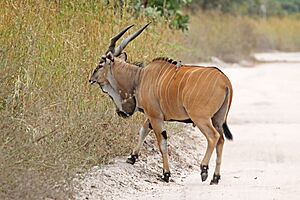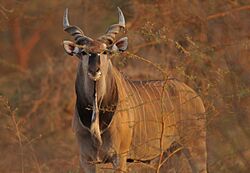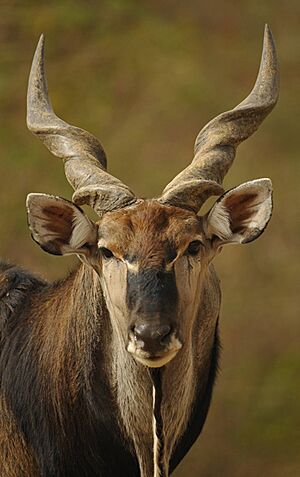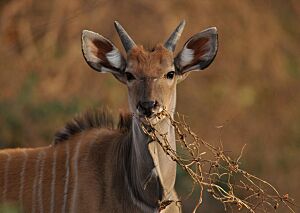Giant eland facts for kids
Quick facts for kids Giant eland |
|
|---|---|
 |
|
| T. d. derbianus Senegal |
|
 |
|
| T. d. gigas at the Cincinnati Zoo | |
| Conservation status | |
| Scientific classification | |
| Subspecies | |
|
|
 |
|
| Distribution of giant eland subspecies: Western giant eland Eastern giant eland |
The giant eland (Taurotragus derbianus), also known as the Lord Derby's eland, is the largest type of antelope in the world. It lives in open forests and savannas in Africa. This amazing animal belongs to the Bovidae family, which includes cattle and goats. It was first described in 1847 by a scientist named John Edward Gray.
Giant elands are plant-eaters, also called herbivores. They usually live in small groups of 15 to 25 elands. These animals are very alert and careful, which makes them hard to spot in the wild. They can run super fast, up to 70 kilometers per hour (43 mph), to escape from predators. Giant elands are found in several African countries, including Cameroon, Central African Republic, and Senegal. Sadly, they are no longer found in some places like Ghana and Togo.
Contents
What's in a Name?
The Scientific Name
The giant eland's scientific name is Taurotragus derbianus. This name comes from three words. Tauros is a Greek word meaning "bull." Tragos is Greek for "male goat," which refers to the tuft of hair in the eland's ear that looks like a goat's beard.
The last part, derbianus, honors Edward Smith-Stanley, 13th Earl of Derby. He was a British nobleman who helped bring the first giant elands to England between 1835 and 1851. The name derbianus means "belonging to Derby."
The Name "Eland"
The word "eland" comes from the Dutch word for "elk" or "moose." It has roots in Baltic languages, similar to the Lithuanian word élnis, which means "deer." The name "giant" in "giant eland" actually refers to its very large horns, not just its body size.
Giant Eland Family Tree
How Scientists Classify Them
The giant eland was first described in 1847 by John Edward Gray. He originally called it Boselaphus derbianus. Today, scientists place the giant eland in the genus Taurotragus, which is part of the Bovidae family.
Sometimes, giant elands are grouped with other antelopes in the genus Tragelaphus. However, they are usually kept in Taurotragus along with the common eland. These two eland species are the only antelopes in their group (called a tribe) that have a different genus name than Tragelaphus.
Different Types of Giant Elands
There are two main types, or subspecies, of giant eland:
| Image | Name | Distribution |
|---|---|---|
 |
T. d. derbianus – Western Giant Eland | Found in western Africa, from Senegal to Mali. |
 |
T. d. gigas – Eastern Giant Eland | Found in central to eastern Africa, from Cameroon to South Sudan. |
What Do Giant Elands Look Like?
Giant elands are known for their spiral-shaped horns. They are the largest antelope species in the world! They can be between 2.2 and 2.9 meters (7.2 to 9.5 feet) long from head to body. They stand about 1.3 to 1.8 meters (4.3 to 5.9 feet) tall at the shoulder.
Male giant elands are bigger than females. Males can weigh from 400 to 1200 kilograms (880 to 2600 pounds), while females weigh 300 to 600 kilograms (660 to 1300 pounds). They have long tails, about 91 centimeters (3 feet) long, with a dark tuft of hair at the end. Giant elands can live for up to 25 years.
Their Coat and Markings
Their smooth coat is reddish-brown, often darker in males. They have 8 to 12 clear white stripes running down their sides. As males get older, their coat color becomes darker.
A short crest of black hair runs down their neck to the middle of their back. Their slender legs are lighter on the inside, with black and white markings just above their hooves. They also have large black spots on their upper front legs. The bridge of their nose is black, and they have a faint tan line between their eyes. Their lips are white, with some white dots along their jaw.
Giant elands have a large flap of skin called a dewlap hanging from their chin to their chest. This dewlap is bigger in males. Their large ears help them hear and also act as a way to signal to other elands. Compared to common elands, giant elands have longer legs and brighter black and white markings.
Their Horns
Both male and female giant elands have tightly spiraled, V-shaped horns. Male horns can be up to 124 centimeters (4 feet) long, while female horns are about 67 centimeters (2.2 feet) long. Male horns are thicker and spread out more than female horns.
Where Do Giant Elands Live?
Giant elands live in the broad-leafed savannas, woodlands, and open areas of central and western Africa. They can also be found in forests and on the edges of deserts. They prefer places near hills, rocky areas, and water sources.
In the past, giant elands lived across a narrow belt of savanna woodland from Senegal to the Nile River. Today, they are mostly found in national parks and reserves. The western giant eland mainly lives in Niokolo-Koba National Park in Senegal. The eastern giant eland can be found in several reserves in Cameroon and the Central African Republic, such as Bénoué National Park and Manovo-Gounda St. Floris National Park. Some are also kept in zoos and special breeding centers.
Life and Behavior
Giant elands are mostly active at night. They have large areas where they roam and may move with the seasons. Males, females, and young elands often form separate groups. Adult males usually live alone but will join female groups for a short time.
Giant eland herds typically have 15 to 25 animals, but sometimes more. These herds stay together even during the wet season. During the day, they often rest in sheltered spots. Like many animals, giant elands use their horns to dig at places where they can lick minerals from the soil.
Staying Safe
Giant elands are very alert and cautious, which makes them hard to get close to. If a male eland senses danger, it will make deep barking sounds and leave the herd, repeating this until the whole herd knows about the threat.
They are incredibly fast, running over 70 kilometers per hour (43 mph). Despite their large size, they are also amazing jumpers, easily clearing fences up to 1.5 meters (5 feet) high. Their main predators are lions, nile crocodiles, and spotted hyenas. Young or sick elands might also be hunted by leopards, cheetahs, and African wild dogs. Because they are so big, they provide a good meal for predators. However, they are not easy prey, especially the large, horned males, which can be dangerous even for a group of lions.
What Do They Eat?
Giant elands are herbivores, meaning they eat plants. They mostly eat grasses and leaves, but also other parts of plants. During the rainy season, they graze in herds and eat grasses. If other food is scarce, they can eat tough, dry grass and weeds. They also enjoy fruits, like plums.
They need to drink water regularly, so they prefer to live near water sources. However, they have special ways to survive when water is scarce. They produce very dry dung, which helps them save water. In deserts, they can get the water they need from juicy plants. They also save water by resting during the day and feeding at night, which helps them stay cool without losing too much water.
Studies have shown that giant elands eat many different plants. In Senegal, they especially like Acacia, Terminalia, and Combretum trees. They also eat fruits from various trees.
Reproduction and Life Cycle
Female giant elands are pregnant for nine months. They usually give birth to one calf at night. The mother stays with her calf for about six months. The calf drinks its mother's milk for four to five months. After six months, the young eland might join a group of other young elands.
A study in Senegal found that giant eland calves suckle more as they get older. Male calves suckled more than female calves. This behavior helps the mother eland stay alert for predators in the wild.
Giant Eland Populations
Eastern Giant Eland
In 1980, the eastern giant eland lived across a wide area from Nigeria to Sudan and Uganda. However, a disease outbreak in 1983–1984 caused their numbers to drop by 60–80%. Today, their population is still decreasing, which is why the International Union for Conservation of Nature (IUCN) lists them as 'Vulnerable'.
About 15,000 eastern giant elands existed in 1999, with most of them in the Central African Republic. Unfortunately, wars and conflicts in some areas can harm their habitats and cause their numbers to decline quickly.
Western Giant Eland
The western giant eland is in a more serious situation. The IUCN lists them as 'Critically Endangered'. Today, most of them live in Senegal. In 1990, there were about 1000 western giant elands, with 700 to 800 in the Niokolo-Koba National Park. By 2008, their population in the park was less than 200, and only a few exist in nearby countries.
Scientists are working on conservation plans for the western giant eland. They are studying populations in reserves like Bandia and Fathala in Senegal. Their goal is to increase the numbers of these rare animals through careful management and breeding programs.
Giant Elands and Humans
Threats and Conservation
The biggest dangers to giant elands are too much hunting for their meat and the loss of their habitat. This happens as human populations grow and more land is used for farming and livestock. Natural problems like droughts and competition with farm animals also reduce their numbers.
The giant eland has already disappeared from countries like The Gambia, Ghana, Ivory Coast, and Togo. Its presence is uncertain in Guinea-Bissau and Nigeria.
Today, the western giant eland is protected in the Niokolo-Koba National Park in Senegal. The eastern giant eland is protected in several national parks in Cameroon and the Central African Republic. They are also bred in special centers, like the Bandia Reserve in Senegal and White Oak Conservation in Florida, USA. Elands born at White Oak have been sent to other countries to start new breeding programs.
Why Are They Useful?
Giant elands provide a lot of tender meat and good quality hides, even if they don't eat the best food. They are also hunted for trophies. Their milk is richer in protein and milkfat than cow's milk, which might explain why eland calves grow so quickly. Eland milk has about three times more fat and twice as much protein as cow's milk.
Because they are calm and have many useful traits, people have tried to tame and raise elands instead of cattle in Africa and Russia. Elands can survive with little water, which is a big advantage over domestic cattle. They can also eat tough grasses and even some poisonous plants that would harm cattle. Plus, they are immune to some diseases that affect cattle.





